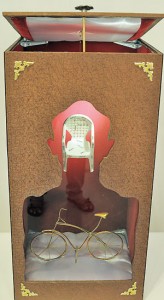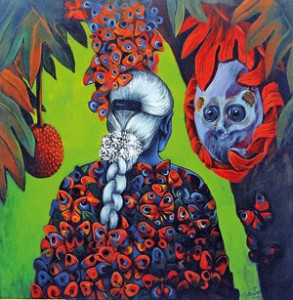Artists reflect their shades of war

Father Memory by Markkandu Manokar
‘C/A/M/P’, or ‘Contemporary Artists’ Meeting Point, is an arts programme organised by the Vibhavi Academy of Fine Arts and the Neelan Thiruchelvam Trust. It connects artists with the aim of facilitating the healing process as they talk about and share their experiences during the war.
Programme coordinator Shyama Jayawardhene feels that artists visiting other artists to gain insight into their lives is important because they can learn together and grow. “We wanted people to learn things such as the way in which artists survived and kept their art going amidst the war whilst facing so many hardships such as the lack of supplies and even art teachers. This experience also helped them understand what different artists from different places went through,” she said.
Art workshops were held in different areas and an exchange programme through which the artists were able to live and experience the culture and environment of other participants all led up to the exhibition now on at the Lionel Wendt Gallery. The exhibition opened on Sunday, July 24 and ends today.
Talking of what he learnt during the programme, Marrkkandu Manokar felt that it is great that Tamils and Sinhalese are working together and building a good understanding of their different languages and religions through this project. “We are doing this because we need to bring understanding,”’ he said, “however I feel that art can help but not completely – other things need to come together as well to reach reconciliation.”
“This is an important exhibition and I feel that we can create a peaceful society through exhibitions like this,” said Thavarasa Thajendran. Everyone has their own ideas and techniques which they use to create art. He also feels that art has a big role to play in reconciliation.
Asanka Manjula May from Colombo calls his painting ‘Paraviya’ (dove). His message is that everyone lost in the war. Dimuthu Wanniarachchi is from Matara and his painting is called ‘Mathakayan’(memories). It has been inspired by the literal ‘writing on the wall’ which he saw in war-affected areas. Hanusha Somasundaram comes from Hatton and her art work is called ‘Identity Card’. She has drawn certain incidents related to the early tea estate workers on the ‘Operating Record Card’ – a card used by the workers to record the quantity of tea plucked. Her aim is to highlight the issues faced by the workers who migrated from Tamil Nadu to the estates of Sri Lanka and faced many hardships. ‘The Chair’ by Hasini Sewwandi Abraham from Colombo seeks to examine if recollections or memories of recollections yield positive results or negative. From Matara Kalani Menaka Wilson’s work ‘Hide’ -deals with all the memories which the earth bears witness to. K.A. Malika Sanjeewani from Gampaha calls her painting ‘Thujiba, A Tamil Woman’. It addresses her friend Thujiba who she sees as the epitome of innocence and beauty which her culture demands of her.

‘Thujiba, A Tamil Woman’- a painting by K.A. Malika Sanjeewani
The artists from the North also had strong themes. Hailing from Jaffna, Krishnapriya Tharmakrishnar’s painting titled ‘Memories of Houses’, is a nostalgic recollection of homes destroyed in the war and the possibility of rebuilding them one day. Marrkandu Manokar from Jaffna lovingly calls his painting ‘Father Memory’. His father is one of the many people who disappeared during the war. Thavarasa Thajendran from Jaffna calls his paintings ‘Concept Note’ to portray the differences in landscape of the areas he visited during the exchange programme. Thujiba Vijayalayan from Jaffna in her painting ‘Social Dynamics’ explores the negative impact which society has on women. Maryathevathas Vijitharan who is from Killinochchi has titled his work ‘Sharing Four Thosay Plates’. He depicts the hardships faced by the people living in LTTE-controlled areas who would take their thosai plates and a few items of food to cook and flee to the jungles. “My Hope’ by Sarmala Shandrathasan from Jaffna reflects the irrevocable fate and hope depicted by horoscopes.
Artists from other parts of the country are also represented. Nalliah Savesan from Ampara calls his work ‘The Dolls’. His art deals with the issue of girls being given in marriage at a young age . In ‘Dragonfly’, Nirosha Wanigasooriya from Gampaha brings out her message of non-violence. Pakkiayarajah Pushpakanthan from Batticaloa calls his painting ‘Burning Series’. It deals with tragic experiences and discourses. From Galle, Pathum Nimesh’s painting ‘Destrot Railway Line’ depicts the railway lines affected by the war and now rebuilt. Susiman Nirmalavasan from Batticaloa captures post war development in war affected areas and the underlying trauma beneath it in her work ‘Shiny Dress’.
What did the artists take away from this experience? Asanka Manjula May says they saw a lot of trauma and heard many tragic experiences but were able to exchange ideas which helped them grow stronger.
‘C/A/M/P’ will be on today at the Lionel Wendt.


